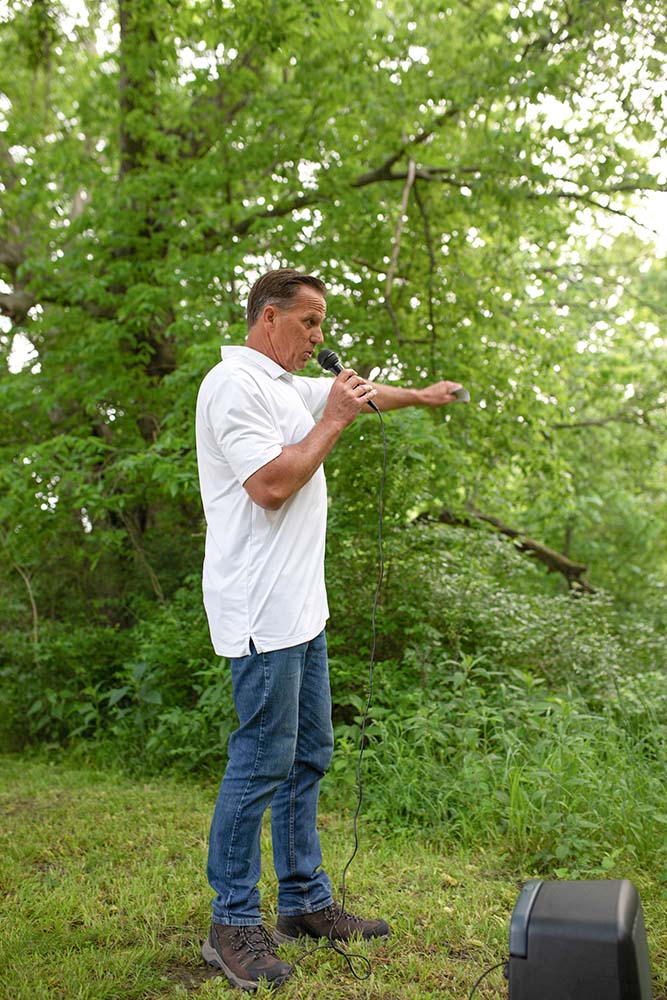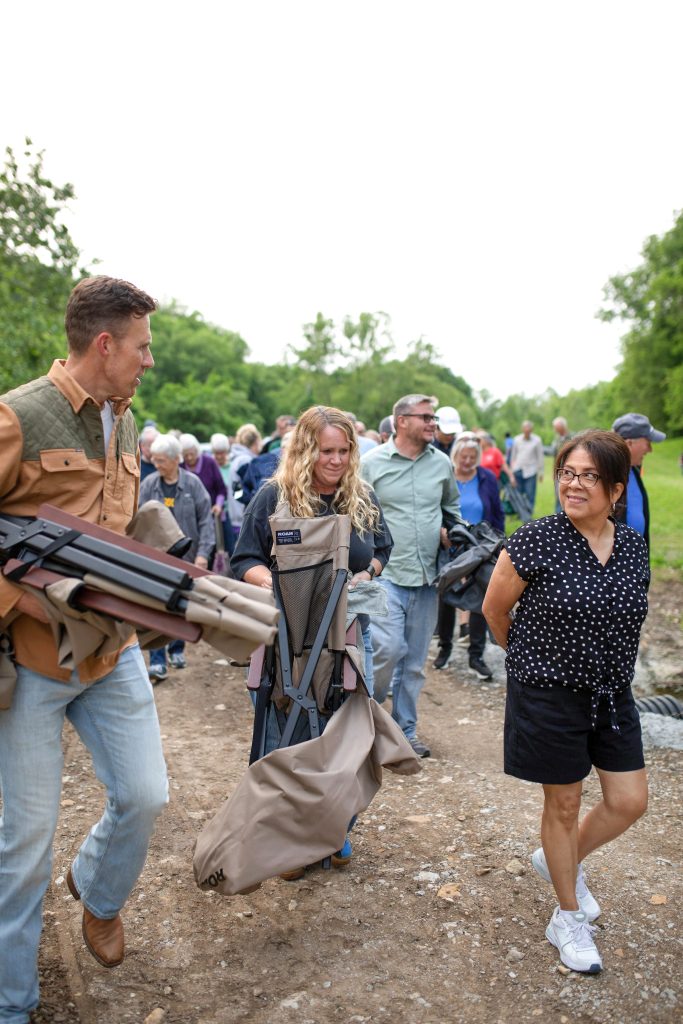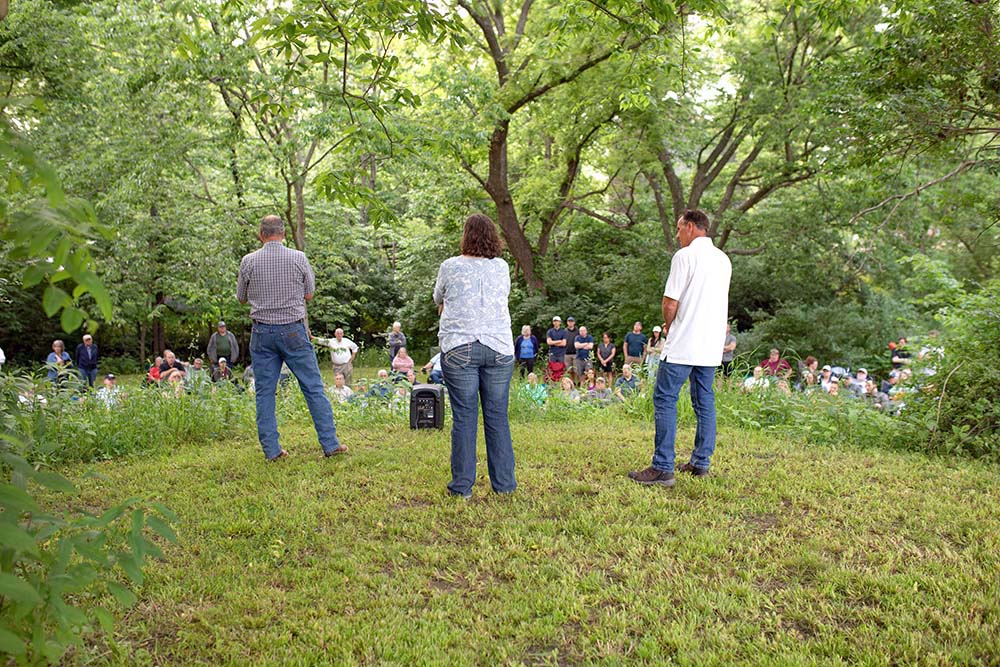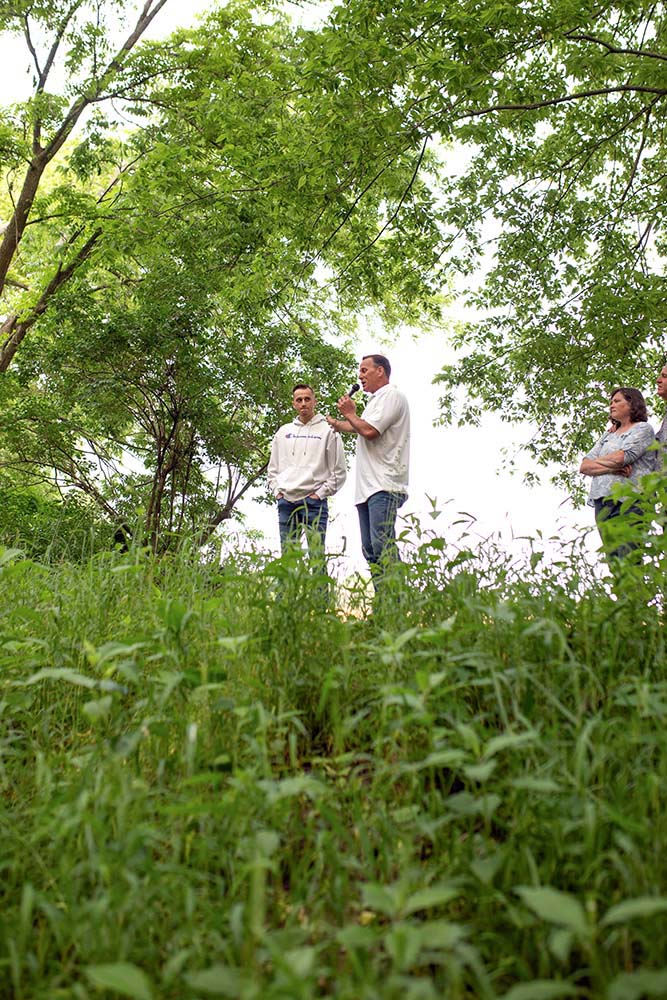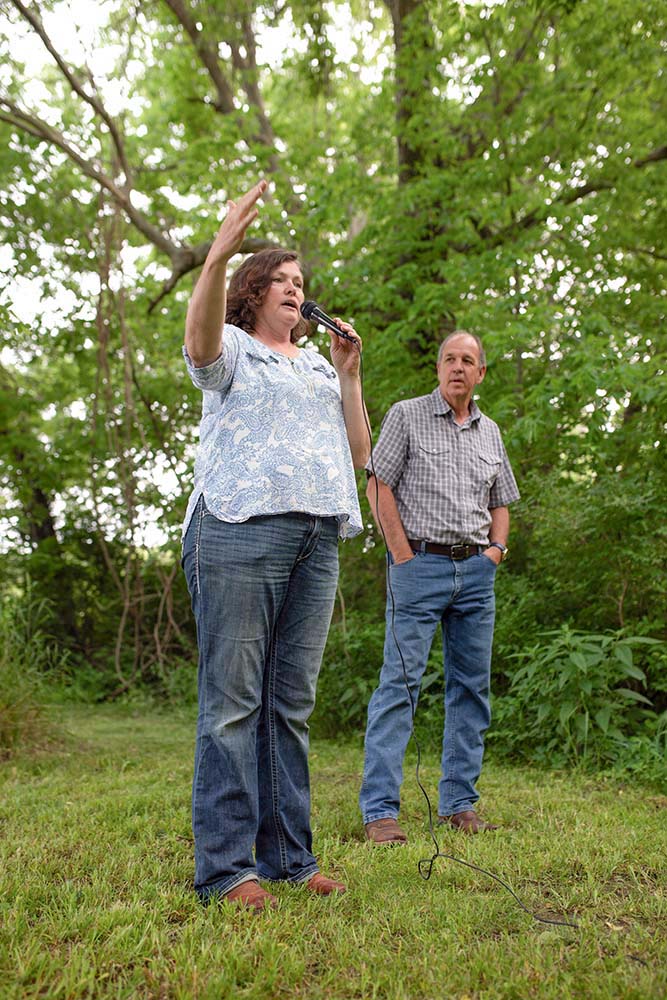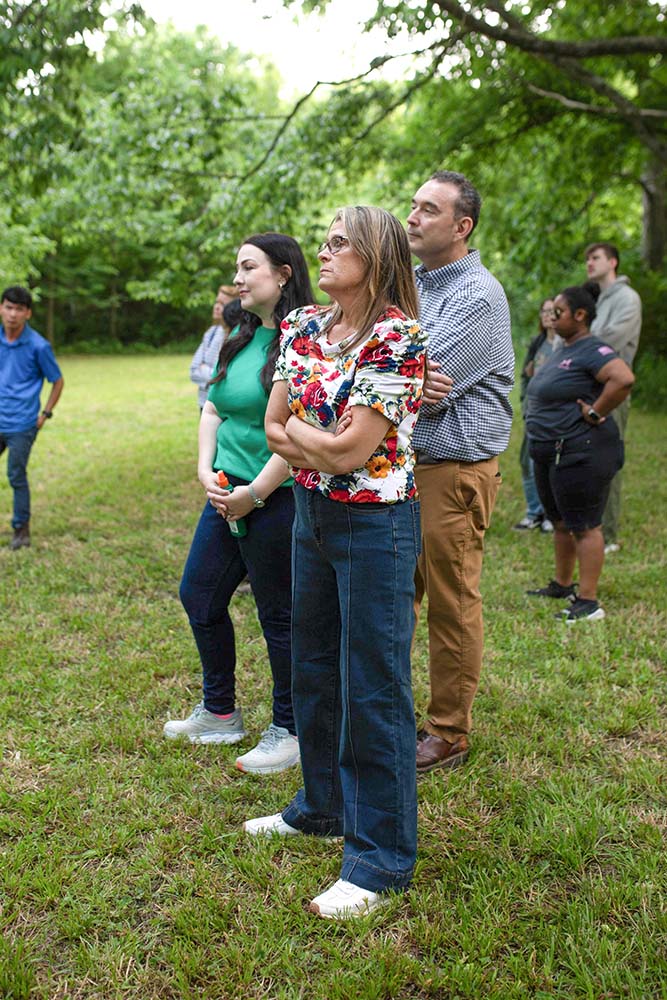News
Features
Calendar
Community Outreach
Missionaries
Honoring Zion's Camp
Tour & Talk Brings Restoration Churches Together to Honor Those Who Died From Cholera
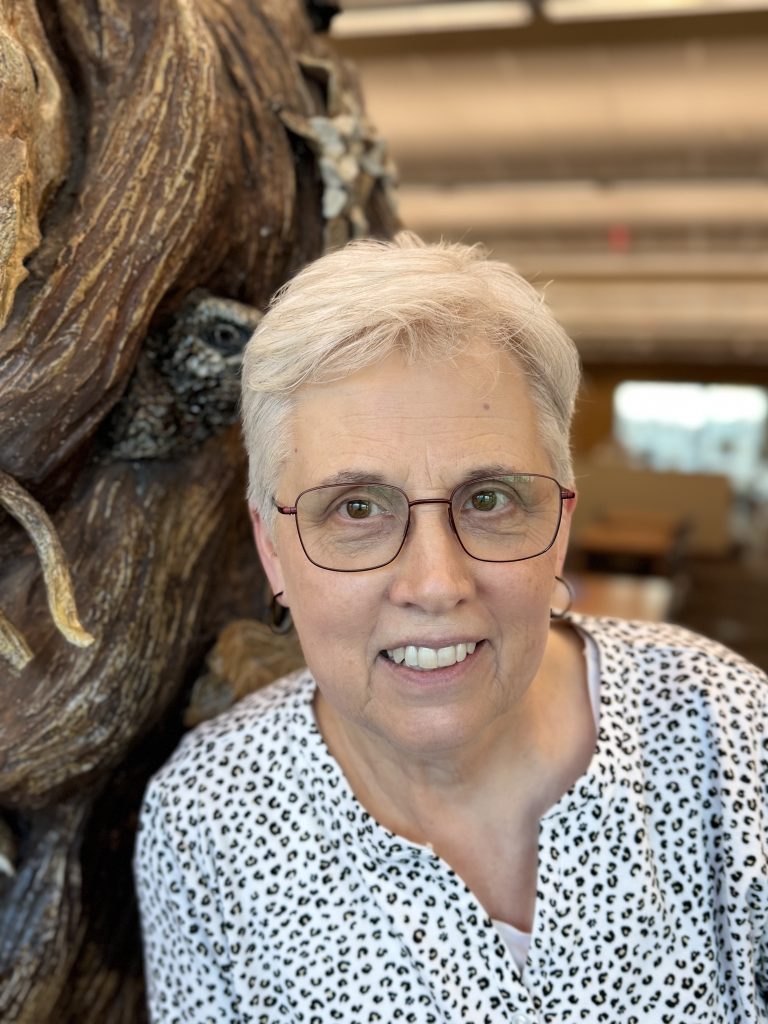
Norma King, Media Director (Rush Creek Ward)
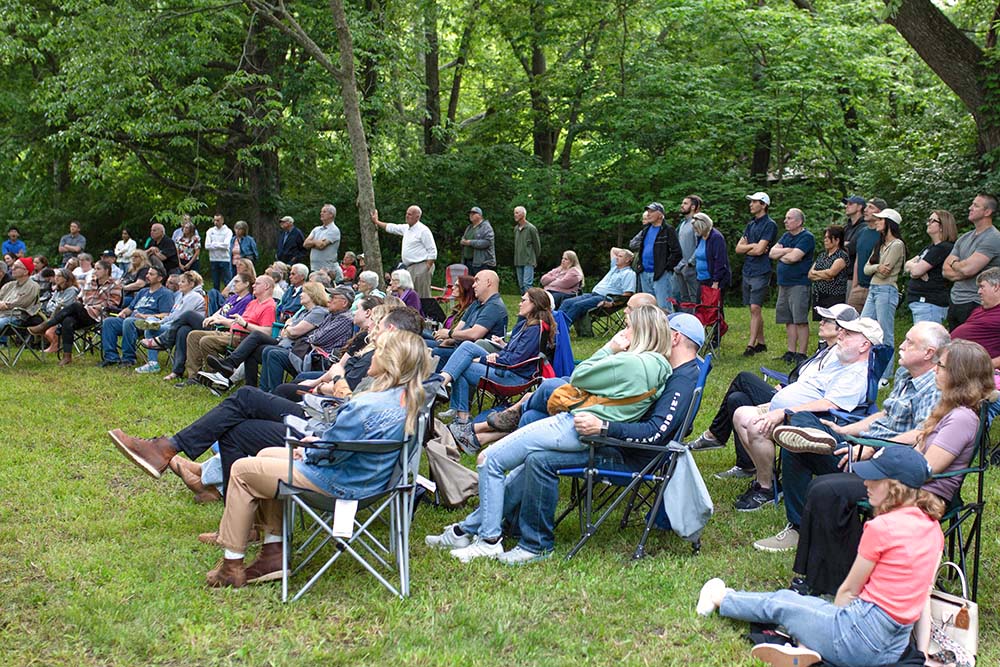
In 1834 the Prophet Joseph Smith led 200 men to Missouri from Ohio to rescue the saints who had been driven from their homes in Jackson County. This Camp of Israel, as it was originally called, is referred to today as Zion’s Camp. Their initial goal was to regain possession of the properties of the saints. After the 900-mile march, the group was disbanded at Fishing River and told that the time for redeeming Zion had not yet come. Days later, in Clay County, many members of the group were plagued with cholera, including the Prophet Joseph. Fifteen eventually died, including one woman and one child. They were buried near Rush Creek on property owned by church members.
More than 120 people gathered on May 30, 2025, in a grassy grove near Rush Creek, east of Liberty, MO, to learn more about the early saints of Zion’s Camp. Those attending included members of both The Church of Jesus Christ of Latter-day Saints, and The Church of Jesus Christ Restoration Branches—brought together by a common interest and love for their restoration heritage.
The story of Zion’s Camp is a witness that “Even though we go through hard things God is there with us,” said Deanne Walker, who owns a portion of the property with her husband Doug.
The Walkers, members of the Rush Creek Ward, and Jay Johnson, a Clay County Commissioner and member of The Church of Jesus Christ South Crysler Restoration Branch, spoke to those gathered about the sacredness of the ground where 15 individuals died of cholera and were buried almost 200 years ago.
“The Lord had a purpose for Zion’s Camp,” said Doug Walker. “In February of the next year [1835], Joseph Smith called a meeting to organize the leadership of the church. All 12 of the apostles and about 25 of the Seventy were called from members of Zion’s Camp. Brigham Young said he learned things from Joseph Smith that taught him how to lead the saints west across the plains to Salt Lake. So there were many great blessings that came out of Zion’s Camp.”
Deanne Walker shared the story of John Murdock, a member of Zion’s Camp who is remembered for giving his twin babies to Joseph and Emma Smith after his wife died in childbirth and the Smith’s babies had passed away.
Another young Murdock daughter, Phoebe, was living with Sidney Gilbert’s family in Clay County at the time and came to visit her father at Zion’s Camp. She was stricken with cholera and died.
“In spite of losing his children and his wife, John Murdock went on to be faithful to the Gospel of Jesus Christ his entire life. I, too, can do that, and so can you as we remember these stories. As we partake of the spirit that is here, we can rely on our Father in Heaven and our Savior Jesus Christ for all things,” said Deanne Walker.
Jay Johnson, whose ancestor, George Burkett, owned the property where Zion’s Camp settled said, “There’s something very, very special about this place. I don’t think Zion’s Camp and the deaths and the cholera were in vain.”
Jay Johnson was raised in California and moved with his family to Missouri in 2016. He knew of his family’s connection with early Mormon history, and that his 4th great-grandparents George and Sarah Burkett, among other saints, had been forced out of Independence, and purchased the property near Rush Creek.
“Joseph Smith Jr. told George and Sarah, if you take these people in [those stricken with cholera] and take care of them, the Lord has told me that no one in your house will be afflicted by this,” said Johnson. And no one was.
However, George and Sarah’s daughter, Catherine, and her husband, Noah Johnson, did not live on the property. Even so, Noah helped bury those who had died of cholera at Zion’s Camp and then a few hours later succumbed to the disease himself and was buried there.
Noah’s wife was pregnant at the time and later had a son whom she named after his father: Noah. Jay Johnson named his own son Noah, not knowing at the time of the connection.
It wasn’t until Jay Johnson had a casual conversation with a neighbor—Soren Nichols (Kellybrook Ward)—that he learned just how close he lived to Zion’s Camp—and the burial ground of his 3rd great grandfather, Noah Johnson.
“Our dog Newport had run into a neighboring property which belonged to the Nichols,” Jay Johnson said. “When we learned they were members of The Church of Jesus Christ of Latter-day Saints, I mentioned to Soren our shared heritage of our two churches’ history, and that my grandparents knew Joseph Smith and were part of Zion’s Camp. Soren then said his nanny’s parents owned that property now and ended up introducing me to the Walkers.”
Johnson shared that the experiences of moving to Missouri, learning about Zion’s Camp and its proximity to his home, his family’s role in Zion’s Camp and even naming his son Noah, not realizing until years later of the family connection, have been surreal.
“How many coincidences does there have to be before you decide God’s in this?” he asked.
Johnson and his wife Nicole have been to the burial site many times, but the night of the tour and talk was the first time their son Noah was able to attend. He had his son come stand with him on the mound during the Zion’s Camp event.
“The promise to George Burkett that no one in his home would die tells us and testifies that we can trust God in all things,” said Deanne Walker. “All his promises are sure. Don’t forget that. His promises are sure. No matter how long it takes for them to come about. No matter what kind of hardship we go through to get to that end goal. God is with us and his promises are sure.”
Many agreed the tour and talk at Zion’s Camp was a spiritual experience.
“I don’t know what the meaning of Zion’s Camp is, but I think there’s more to it than just the history and whether this is a place that we’ve at least brought some different branches of the restoration here,” said Jay Johnson.
“What an amazing spiritual experience it was to learn more of the history of Zions Camp and the faith of our pioneer ancestors,” Newly-called Stake President of the Liberty Missouri Stake, Matthew Russell, said. “The spirit was so strong as we listened to Jay Johnson talk about his ancestors. It was so evident as we listened to the experiences shared that the Lord is always watching over us and directing us in our lives.”
President Russel’s wife Heidi agreed saying, “As I sat among saints in that grove of trees my heart was filled with the spirit of both the history of what happened in that very place and the people I was surrounded by. There is truly something so special about this place we call home, and I am so grateful this is where we landed! Great things will continue to happen here and I don’t want to miss a moment!”
Johnson talked about the shared history of the Restoration Branches and The Church of Jesus Christ of Latter-day Saints.
“We have more in common than we know,” Johnson said. “I’m glad [these different restoration churches] can come together about our shared history. We need each other.”
The Walkers agreed and were happy to host the event and open their property to those who are interested.
“When the Lord knows a piece of property on the earth is special. It stays special.”
To that end, the Walkers invite anyone interested to come out to the property, sit, ponder, read and feel the spirit.
“Because this is not our place, this is God’s, and we are only his stewards here. So if you have a need or a desire, please come whenever you would like,” Deanne Walker concluded.
This event was unique because we were able to spend time with both church and community friends,” Kristine Jones (Doniphan Ward) said. “ I loved hearing Jay Johnson’s journey to discovering his family connection to Zion’s Camp and the burial grounds near Rush Creek. It is a privilege to live so close to sacred places such as this, and I’m grateful to the Walkers who make it available to anyone, anytime.”
The victims of cholera were buried in a small bluff ½ mile off of Richfield Road outside of Liberty. In the 1950s rain washed out part of the bluff and exposed the bones of three individuals.
When the farmer owning the property discovered the bones he contacted authorities who sent the bones to be tested and determined they belonged to early saints who were part of Zion’s Camp. The bones of those three individuals—one being a child—were buried in Mound Grove Cemetery in Independence, near the graves of leaders of the Reorganized Church of Jesus Christ of Latter Day Saints (RLDS), now known as Community of Christ, The remains of the other 12 who died are still buried in the small bluff ½ mile off of Richfield Road.
